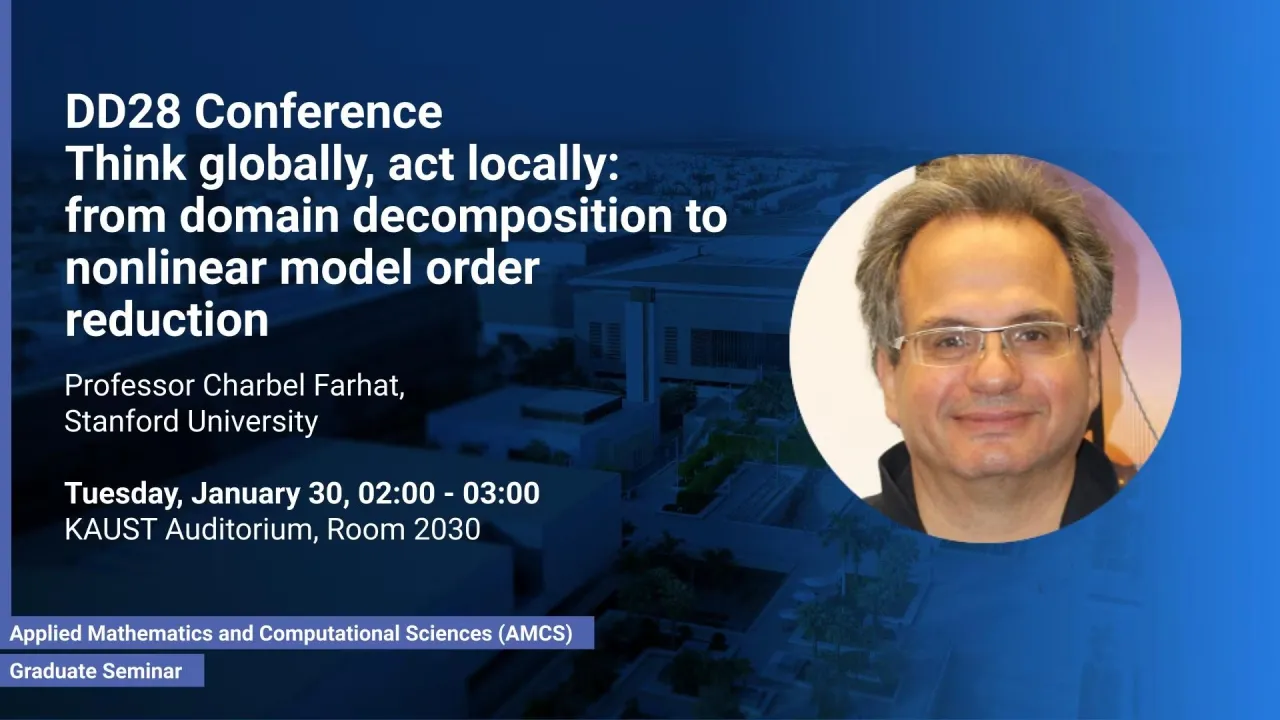
Think globally, act locally: from domain decomposition to nonlinear model order reduction
- Prof. Charbel Farhat
KAUST Auditorium R2030
Overview
Abstract
The Finite Element Tearing and Interconnecting (FETI) methodology is a family of domain decomposition (DD)-based iterative methods for the fast solution on massively parallel processors of large-scale systems of equations arising from finite element (FE) spatial approximations. Developed in its basic form in 1991, it has been extended and refined during 18 years to enable ever faster and more accurate analyses of a broad range of engineering and pathfinder systems such as re-entry vehicles, modern aircraft, advanced Formula 1 cars, aircraft carriers, underwater systems, electronic packages, and nano-scale optical shutters. FETI has made a significant impact on mechanical finite element analysis software worldwide. This impact was recognized in 1997 by the IEEE Sidney Fernbach Award. By the end of the year 2001, FETI was incorporated in many FE commercial codes including ANSYS in the US and SAMCEF in Europe. It was also chosen by the Sandia National Laboratories to power their workhorse structural dynamics code SALINAS. In 2002, the FETI-SALINAS mechanical software demonstrated numerical and parallel scalability on up to 2,940 ASCI Red and 3,375 ASCI White processors; it won the coveted IEEE Gordon Bell Award. The FETI method tailored for the solution of Helmholtz problems was deployed at DOD’s Major Shared Resource Centers and chosen by Northrop Grumman Newport News and Electric Boat to accelerate the evaluation of the acoustic signatures of ships and underwater vessels. Inspired by relevant DD conceptual advances subsequently made by O. B. Widlund and his co-workers, a multilevel generalization of the dual-primal FETI method known as FETI-DP was developed between 2015 and 2018 to enable the efficient and massively parallel solution on tens of thousands of cores of FETI’s natural coarse problem – which until then had been solved either serially or in parallel but on a small fraction of the number of cores allocated to a FETI run. The multilevel FETI-DP method demonstrated numerical and parallel scalability on up to 32,768 cores of a CRAY XC40 system, and the ability to solve real-world problems with more than 21 billion degrees of freedom in less than five minutes wall-clock time. This lecture will overview the FETI development journey, the influences of O. B. Widlund and the DD organization on it, and its impact on industry. It will also highlight connections with projection-based model order reduction that have led the speaker to research this topic subsequently to advance the field of physics-based machine learning. It will conclude with an overview of a game changing computational technology grounded in the think globally and act locally paradigm, and its recent impact on digital twinning for applications ranging from the ground vibration testing of aircraft to model predictive control for their autonomous landing.
Brief Biography
Charbel Farhat is the Vivian Church Hoff Professor of Aircraft Structures and the Director of the Stanford-King Abdulaziz City for Science and Technology Center of Excellence for Aeronautics and Astronautics in the School of Engineering at Stanford University. His research interests are in computational engineering sciences for the design and analysis of complex systems in aerospace, mechanical, and naval engineering. He is a Member of the National Academy of Engineering; the Royal Academy of Engineering (UK); and the Lebanese Academy of Sciences. He is a designated ISI Highly Cited Author, a Vannevar Bush Faculty Fellow, and a Fellow of AIAA, ASME, IACM, SES, SIAM, USACM, and WIF. He has trained more than 90 PhD and post-doctoral students. For his research on aeroelasticity, aeroacoustic scattering, CFD, domain decomposition, dynamic data-driven systems, fluid-structure interaction, high performance computing, and model reduction, he received many professional and academic distinctions including: the Ashley Award for Aeroelasticity and the Structures, Structural Dynamics and Materials Award from AIAA; the Lifetime Achievement Award and the Spirit of St Louis Medal from ASME; the Gordon Bell Prize and the Sidney Fernbach Award from IEEE; the Gauss-Newton Medal from IACM; the Grand Prize from the Japan Society for Computational Engineering Science; the John von Neumann Medal from USACM; the Olof B. Widlund Prize; and the Modeling and Simulation Award from the DoD. He was knighted in France in the Order of Academic Palms and awarded the Medal of Chevalier dans l’Ordre des Palmes Académiques.